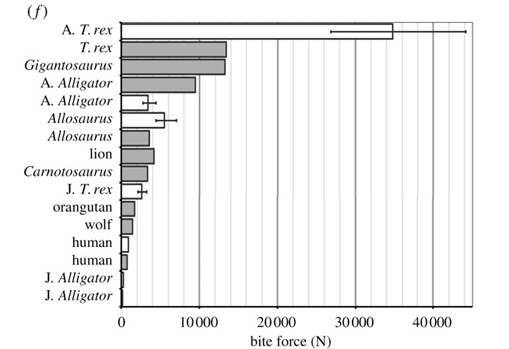6x may be a bit of an overstatement now that I look at it, but the upper limit is still over 4x that of Gigaonotosaurus'.
And far less at the lower limit, so you'd better take the best estimate. Even better is to scale from their own estimate for Allosaurus, not a figure they just quoted, so the figures will at least be roughly compatible.
Again, that would yield about 3t of bite force, not that it mattered much...
No, an ant's bite is relatively weak for it's size. In fact, an ant is generally far weaker than a human of equal size. Scaled up to our size it would collapse under it's own weight (not to mention it would suffocate anyway

).
There is no evidence for this. All the data basically speaks of cursoriality.
To some degree, not even close to being as effective. This is the payoff I'm talking about.
Carcharodontosaurs also have neck muscles.
Thickness of the neck vertebra is not the same as neck-muscle strenght.
How robust it is also has to do with how big it is. A gunea pig is much more compact than a Girtaffe, but of course it is dwarfed by it in any regard.
besides, nobody here doubt's
T. rex has the stronger bite force, this just simply is not a relevant factor, and it's skull does by no means dwarf that of
Giganotosaurus in the way that image makes you think. One of the quotes I probably most often recite is "Adductor-driven bite force is not a good predictor of killing performance among ziphodont taxa".
Nope, it does not.
People have also survived getting their necks broken, does that mean they would fight afterwards? Besides, I'd like the accounts were people survived (outside an ER or OR) a carotid and jugular dissection.
A bite to the neck by a carcharodontosaur is a near-instant kill to any similar-sized animal, a few seconds in shock, bleeding and with cut muscles are no time in which any animal could strike back.
Tyrannosaurus bite ensures a quick kill in the case of a neck bite, or one to the skull. Nowhere else, for it couldn't even bite the torso due to it's girth.
You're still getting me wrong. I'm by no means talking about a killing weapon. as I explained earlier, I'm talking about grappling hooks.
Since you apparently think Something could survive having it's throat cut and still fight back, how about seizing it after delivering the bite?
I admit that was a rather bad analogy, but it's irrelevant. Both may be able to dodge to some degree, neither for long. But speed has nothing to do with this
Did I claim so?
OK, do you see wolves killing cougars all day?
Thanks, but I'm fully aware of tyrannosaurid pathologies. That still doesn't mean any given other theropod wasn't just as agressive, and most likely coexisted with a greater number of other large predators.
It would limit it's gape and force it to develope sturdier and in consequence blunter teeth as well as a heavier skull limiting the speed with which it can place a bite.
This would cause it to be unable to bite most parts of it's prey, and make it's attack on those parts it could bite less effective and slower.
eg. if a Tyrannosaurus tried to bite the leg of a sauropod, it would take time to bite down and gnaw, pull and twist at the bone, eventually breaking it (unless it is just too big to do so, which may also be the case with some sauropods). A Giganotosaurus on the other hand would just have to nip at the leg to sever tendons and blood vessels, something that takes only one quick slash, and it would have no problems actually biting the belly due to it's gape.
A cut throat also is. I think you should check out the "slicing bite vs crushing bite" thread
I explained this earlier. Btw Really sorry if I'm sounding a bit too rude, that's not meant to be this way.
we cannot be sure of that, it may also be that the estimate was for a large and/or large skulled specimen, and was simply very conservative. That wouldn't impact the bite force.
Thanks, I'll look at that tomorrow.
So could
T. rex should it miss it's target.
This was sometime after the study saying Komodo dragons had a weaker bite force than house cats, which was presented in 2008.
I guess you meant to write "discapacitate"

Anyway, that's because
A: they often hunt animals much larger than themselves
B: they bite the legs, not the neck
C: they and their prey are both smaller, meaning more resistant due to the square cube law.
And of course we should not forget they still incapacitate much of their prey pretty quickly, since shock also comes quickly. You should ask
coherentsheaf about this, he's our dragon specialist along with VD.
I'm not sure of that. Those strong neck muscles in turn will take longer to move the skull and make the structure less flexible, just like a bigger, more massive animal (eg. T. rex) isn't as fast as a smaller one (eg. Albertosaurus), despite it's greater muscle mass.
Then again, the hard data (look at the other Snively et al., 2007) is not suggestive of as massively stronger neck muscles as often portrayed. Tyrannosaurs merely have bigger lateroflexors (Jaw mechanics thread), and much of the internal structure is the thicker bone needed to bear the skull and the
Well, for once, Allosaurids have tremendously strong crania, but I'm unsure whether and how much this applies to Carcharodontosaurs. Secondly, the high mechanical advantage is what applies that force effectively.
Thirdly, I'm of course speaking of a bite force twice lower than that of
T. rex, not one equally powerful, which still fully suffices for their jaws.















 ).
).